I’ve only been here three days and there’s a shooting. I know you’re my agent, but this place is fantastic. It’s like Gone With the Wind on mescaline. Listen to me, they walk imaginary pets here, Garland. On a fucking leash. And they’re all heavily armed and drunk. New York is boring!”
– John Kelso, in Midnight in the Garden of Good and Evil
Buenos Aires – You all remember the whole Adam, Eve, and the snake thing, right? I don’t have to go into detail I hope. Not that we have much detail, it’s all very cryptic, which has made for great conversations amongst scholars who like to spend their lives in debate over the fine points. This weekend was the 340th anniversary, always an important one, of the date when John Milton sold Paradise Lost for a whopping ten pounds. I don’t know if that was good money for a book in 1667, but it seems to me that he lost out on a whole lot more than Paradise. Regardless, we here at Casa S decided to pay a little homage in the form of a dinner based on the Garden of Eden, or more specifically, the Tree of Knowledge – you know, the one they ate the fruit from. The question is, just exactly what fruit? And that’s been the debate over the millenia…
In the debate among the Talmudic Sages as to what exactly was the food of the Tree of Knowledge from which Adam ate, it is the position of Rabbi Yehuda that it was wheat. This is a sharp departure from the positions of his colleagues who identify that tree as one which bore grapes or figs. The basis of Rabbi Yehuda’s compulsion to identify this sinful food as wheat, despite the obvious difficulty of connecting wheat with a tree, is the fact that this tree is described by the Torah as one whose food imparts knowledge. A baby, he points out, does not have the understanding to say the words “father” and “mother” until it eats wheat. It is logical, therefore, to assume that only food which imparts such understanding in a child could be considered the food which gave man the knowledge to distinguish good from evil.
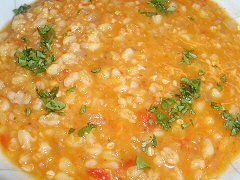 Well, thanks to Rabbi Yehuda, we get to keep playing with wheat berry soups. I feel an article in the offing… I have a recipe that I picked up awhile back for a wheat and red lentil soup that sounded like a good base to start from. It’s hearty, tasty, and from having made it before, a trifle bland. But that’s an easy fix with some herbs and spices – the original was nothing more than vegetable stock with wheat and lentils in it, a dash of tomato paste was about as exciting as it got. For our version, chop a white and red onion and saute in a bit of olive oil until soft and translucent. Add a cup of wheatberries, a cup of red lentils, and ½ cup of buckwheat. Puree a couple of roasted piquillo peppers (one can of 200gm was a good amount) with some vegetable stock, add to the pot and top off with more vegetable stock. Bring to a boil, reduce heat to simmer, and cook for about 20 minutes until the grains are cooked through, adding more liquid if needed – I like this soup fairly thick, almost stew like, but it’s at your option. Stir in some chopped cilantro and season with salt, garnish with more cilantro.
Well, thanks to Rabbi Yehuda, we get to keep playing with wheat berry soups. I feel an article in the offing… I have a recipe that I picked up awhile back for a wheat and red lentil soup that sounded like a good base to start from. It’s hearty, tasty, and from having made it before, a trifle bland. But that’s an easy fix with some herbs and spices – the original was nothing more than vegetable stock with wheat and lentils in it, a dash of tomato paste was about as exciting as it got. For our version, chop a white and red onion and saute in a bit of olive oil until soft and translucent. Add a cup of wheatberries, a cup of red lentils, and ½ cup of buckwheat. Puree a couple of roasted piquillo peppers (one can of 200gm was a good amount) with some vegetable stock, add to the pot and top off with more vegetable stock. Bring to a boil, reduce heat to simmer, and cook for about 20 minutes until the grains are cooked through, adding more liquid if needed – I like this soup fairly thick, almost stew like, but it’s at your option. Stir in some chopped cilantro and season with salt, garnish with more cilantro.
In the Talmud, Rabbi Nechemia says that the fruit was a fig. Adam and Eve used fig leaves to cover themselves after eating the fruit (Genesis 3:7). Perhaps this was because the leaves were nearby, or perhaps it shows God creating the cure before the illness, i.e. the same tree that caused the problem was then used to remedy it. Another explanation lies within the “fruit” of the fig tree, the fig itself, which is not actually a fruit but rather a flower of sorts, serving as the tree’s genitalia.
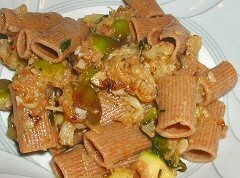 I take no credit for much of anything in this recipe, having pretty much lifted it from Debbie at words to eat by. The only changes I made to her recipe were that I used fresh figs rather than plumping up some dried black figs – they just came into season recently and I’ve been wanting to use them in something interesting – and I left out the pinenuts as we had people coming on two of our three nights open this weekend who had nut allergies – I’m simply not sure if pinenuts fit into that, and neither were they, but why take a chance? It’s delicious, and a great, hearty sort of late fall pasta dish. I love roasted cauliflower, and I could see just dropping the pasta and figs and simply roasting the cauliflower with the cayenne and rosemary.
I take no credit for much of anything in this recipe, having pretty much lifted it from Debbie at words to eat by. The only changes I made to her recipe were that I used fresh figs rather than plumping up some dried black figs – they just came into season recently and I’ve been wanting to use them in something interesting – and I left out the pinenuts as we had people coming on two of our three nights open this weekend who had nut allergies – I’m simply not sure if pinenuts fit into that, and neither were they, but why take a chance? It’s delicious, and a great, hearty sort of late fall pasta dish. I love roasted cauliflower, and I could see just dropping the pasta and figs and simply roasting the cauliflower with the cayenne and rosemary.
Pomegranate as Forbidden Desire was a component of its meaning within Athena’s Parthenon, but the forbidden desire to eat of the fruit also underlays the Persephone myth. In Jewish lore it was again the fruit of things forbidden, growing upon the Tree of Knowledge (of sexuality & death) forbidden to Adam & Eve. For the mystic Moses Cordovero, pomegranates represented the divine emanations of God such as dwelt upon the Sephiroth Tree, with both dark & light aspects. In the Song of Songs Rabbah, we are told that the seeds of a pomegranate represent children studying Torah, which may bear some relationship to an idea from Islamic legend, that each seed of the pomegranate is capable of producing a different fruit from paradise.
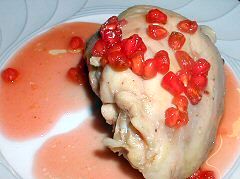 Another fruit which just came into season here is the pomegranate, conveniently, another of our contestants for the tree of knowledge. I honestly can’t remember the last time I worked with fresh pomegranates, probably about a dozen years ago or so. At least within my circle of friends, they’re definitely an underused fruit, other than in the form of, say, grenadine in a cocktail – most of which, these days, isn’t made with real pomegranates anyway. I wanted to combine this with a confit – I’d love to do it with duck legs, but that’s a tough purchase here in BA – not just to find, but when you do, duck here tends to be a bit on the stringy side, not to mention I’ve never seen them sold anyway but whole – so let’s see, for three dozen people over three days… 18 whole ducks at about 40 pesos apiece… nah. Marinate chicken thighs in lots of chopped garlic, some salt, and lots of olive oil overnight. Then, in a deep pan, like a dutch oven, pour the whole thing, marinade and all (the oil should come up about halfway on the chicken), and over a low flame, cover it and cook it all slowly until the chicken is done, turning the pieces regularly – it’ll come out very tender and flavorful. For the sauce, seed a couple of pomegranates – that’s a fun trick in itself. Then, in a small saucepan, simmer together the seeds, a splash of grenadine for extra color, a cinnamon stick, the juice of a lemon, a cup of chicken stock, and season with salt and pepper. Spoon the sauce over the chicken and serve.
Another fruit which just came into season here is the pomegranate, conveniently, another of our contestants for the tree of knowledge. I honestly can’t remember the last time I worked with fresh pomegranates, probably about a dozen years ago or so. At least within my circle of friends, they’re definitely an underused fruit, other than in the form of, say, grenadine in a cocktail – most of which, these days, isn’t made with real pomegranates anyway. I wanted to combine this with a confit – I’d love to do it with duck legs, but that’s a tough purchase here in BA – not just to find, but when you do, duck here tends to be a bit on the stringy side, not to mention I’ve never seen them sold anyway but whole – so let’s see, for three dozen people over three days… 18 whole ducks at about 40 pesos apiece… nah. Marinate chicken thighs in lots of chopped garlic, some salt, and lots of olive oil overnight. Then, in a deep pan, like a dutch oven, pour the whole thing, marinade and all (the oil should come up about halfway on the chicken), and over a low flame, cover it and cook it all slowly until the chicken is done, turning the pieces regularly – it’ll come out very tender and flavorful. For the sauce, seed a couple of pomegranates – that’s a fun trick in itself. Then, in a small saucepan, simmer together the seeds, a splash of grenadine for extra color, a cinnamon stick, the juice of a lemon, a cup of chicken stock, and season with salt and pepper. Spoon the sauce over the chicken and serve.
The claim that Eve “pressed grapes” and gave Adam wine to drink (Midrash Bereishit Rabbah 19), as surprising as it sounds, is the most widespread answer. Linguistically it is based on what is said in the Torah, “and she (Eve) took from its fruits” (Bereishit 3:6). Since it does not say “she took its fruits” but rather “from its fruits”, one can claim that Eve created something from the fruit, the bunches of grapes, and this she gave to Adam.
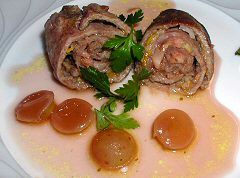 Beef and grapes, a combination I happen to like alot – whether it’s in the form of a reduced wine sauce, or a steak with a grape sauce. Since I’ve been playing a bit with different types of roulades recently, I decided to go with a beef roulade – in this case, thin scallops of lomo, or sirloin, rolled around a filling made of sauteed leeks, shallots, bacon, and breadcrumbs, roasted in the oven, and then topped with a sauce made from 1 cup beef stock, 1 cup seeded grape halves, ¼ cup butter, ½ cup sherry, and ½ cup red wine – simmer it all together for about ten minutes, season to taste, spoon over the beef rolls, and garnish with some parsley or other herbs of your choice.
Beef and grapes, a combination I happen to like alot – whether it’s in the form of a reduced wine sauce, or a steak with a grape sauce. Since I’ve been playing a bit with different types of roulades recently, I decided to go with a beef roulade – in this case, thin scallops of lomo, or sirloin, rolled around a filling made of sauteed leeks, shallots, bacon, and breadcrumbs, roasted in the oven, and then topped with a sauce made from 1 cup beef stock, 1 cup seeded grape halves, ¼ cup butter, ½ cup sherry, and ½ cup red wine – simmer it all together for about ten minutes, season to taste, spoon over the beef rolls, and garnish with some parsley or other herbs of your choice.
In Western Christian art, the fruit is most commonly depicted as an apple. One possible reason for this arises from a medieval pun. It was a source of humor to monks that the Latin word for evil was similar to the word for apple. Thus it was often said that by eating the malum (apple), Eve contracted malus (evil). There is, however, no textual or historical evidence by which to argue the literalness of this image.
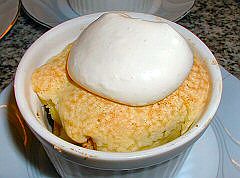 Oh those wacky monks and their puns… This is based on a recipe I’ve made many times before that comes from a Russian cookbook, Please To The Table. The only change I made was experimenting a bit with the spices – I’ve been having fun with that garam masala mixture that I used in our Pakistani dinner recently. It seemed like it would work on apples just as well. Slice up six apples and toss with ¼ teaspoon each of ground cinnamon, cloves, nutmeg, cardamom, and laurel (bay leaf). Divide into a dozen ramekins. To make the batter, beat 3 eggs and 1 cup of sugar together until light yellow and fairly thick. Add a cup and a half of sifted cake flour and 2 teaspoons of vanilla. Pour over the apples. Bake at 350°F for about 40 minutes, until all golden brown. Let cool, serve at room temperature with whipped cream made with brown sugar.
Oh those wacky monks and their puns… This is based on a recipe I’ve made many times before that comes from a Russian cookbook, Please To The Table. The only change I made was experimenting a bit with the spices – I’ve been having fun with that garam masala mixture that I used in our Pakistani dinner recently. It seemed like it would work on apples just as well. Slice up six apples and toss with ¼ teaspoon each of ground cinnamon, cloves, nutmeg, cardamom, and laurel (bay leaf). Divide into a dozen ramekins. To make the batter, beat 3 eggs and 1 cup of sugar together until light yellow and fairly thick. Add a cup and a half of sifted cake flour and 2 teaspoons of vanilla. Pour over the apples. Bake at 350°F for about 40 minutes, until all golden brown. Let cool, serve at room temperature with whipped cream made with brown sugar.